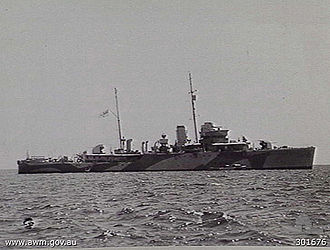HMAS Warrego (U73)
|
|
|
|---|---|

|
|
| period of service | |
| Builder: | Cockatoo Island Dockyards |
| Keel laying: | May 10, 1939 |
| Launch: | February 10, 1940 |
| Commissioning: | August 21, 1940 |
| Fate: | Decommissioned on August 15, 1960, scrapped in 1966 |
| Technical specifications | |
| Ship type : | Sloop |
| Displacement : | 1,060 ts standard 1,370 ts maximum |
| Length: | 79.8 m |
| Width: | 10.8 m |
| Draft : | 2.25 m |
| Drive : | 2 Admirality 3-drum steam boiler Parsons steam turbines with single gear 2,000 WPS on 2 screws |
| Speed : | 16.5 kn |
| Range: | 5,700 nautical miles at 10 kn |
| Crew : | 135 |
| Armament: | 3 × QF 4-inch ship guns Mk V (3 * 1) 4 × 3-pdr guns 1 MG 2 launchers for depth charges |
The HMAS Warrego (U73) was the second after the Warrego River named ship of the Royal Australian Navy and a sloop of Grimsby class , which during the Second World War was in use and in the post-war period until the 1960th The Royal Navy designated quite slow escort ships primarily for fighting submarines as sloops . Sloops were distinguished from corvettes and escort destroyers by a greater range, which is why they were predestined to accompany convoys even in remote areas.
history
Second World War
The Warrego was laid down on May 10, 1939 in the Cockatoo Island Dockyards , Sydney and put into service by the Australian Navy almost a year after the start of the war on August 15, 1940. For the first year and a half she was the flagship of the 20th mine clearing flotilla, which was supposed to keep the waters around the Australian south coast free of enemy sea mines . Several German auxiliary cruisers , such as the Pinguin , laid minefields there in October and November 1940. This task lasted until December 3, 1941, when the Warrego was relocated north due to the emerging outbreak of the Pacific War , first to Port Moresby , then to Darwin , where it arrived on January 9, 1942.
From Darwin, the sloop was mainly used for submarine hunting and as an escort for convoys that transported supplies for the Allied ABDA forces that were supposed to stop the Japanese advance in Southeast Asia . The Warrego had its first enemy contact as part of the escort for a convoy to Kupang , which had loaded urgently needed reinforcements for the defense of Timor , including an Australian engineer battalion and an artillery battalion of the US Army . The escort was correspondingly large, in addition to the Warrego the heavy cruiser USS Houston , the destroyer USS Peary and the sloop HMAS Swan , a sister ship of the Warrego . The convoy was attacked by 54 Japanese aircraft on February 16. There was only slight damage in the convoy from close hits, but due to the severity of the attack and since further heavy attacks were to be expected before reaching Kupang, the convoy was forced to return to Darwin. Three days later, the Warrego was therefore in the port of Darwin when the machines of four aircraft carriers of the Kidō Butai attacked the city on February 19. The air raid on Darwin caused severe damage to the city, numerous ships were sunk or damaged, including the four transporters of the convoy and the Peary , which sank after five hits. The Warrego itself was lucky and not damaged. She then called at Sydney, where she was refitted by the end of May 1942.
After being refitted, the sloop was sent to the Port Moresby area . In addition to anti-submarine patrols, her main task was escorting convoys between New Guinea and Australia. She fulfilled this task until mid-1944, interrupted by a lengthy overhaul of the ship in Brisbane from June to September 1943. The only enemy contact she had was the unsuccessful attack by an isolated Japanese aircraft on February 23, 1943. Finally, the Warrego became in December assigned to the Allied naval forces, who carried out the landing on Luzon in January 1945 as part of the reconquest of the Philippines . Until May 1945, the Warrego carried out escort and reconnaissance missions in the Philippines. Then she returned to the New Guinea area; Among other things, it fired at Wewak in June in support of the Australian ground troops fighting there and took part in the Allies' reconquest of Borneo in July . At the time of Japan's surrender , the sloop was in Sydney for overhaul.
post war period
In the immediate post-war period, the Warrego was used in the waters around Borneo, then returned to Australia in December 1945 and was mainly used for reconnaissance tasks in the waters around Australia. So they explored for example, 1951, the Montebello Islands as part of the preparations for Operation Hurricane , the first nuclear weapons test Britain in 1952. In June 1960, she undertook Mackay (Queensland) on the search and rescue operations for a downed Fokker F-27 of the Trans Australia Airlines participate.
On August 15, 1960, the Warrego was decommissioned and scrapped in 1966.